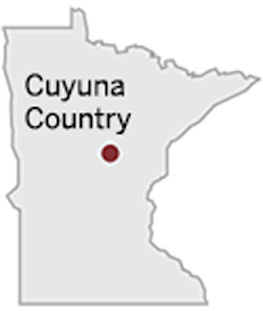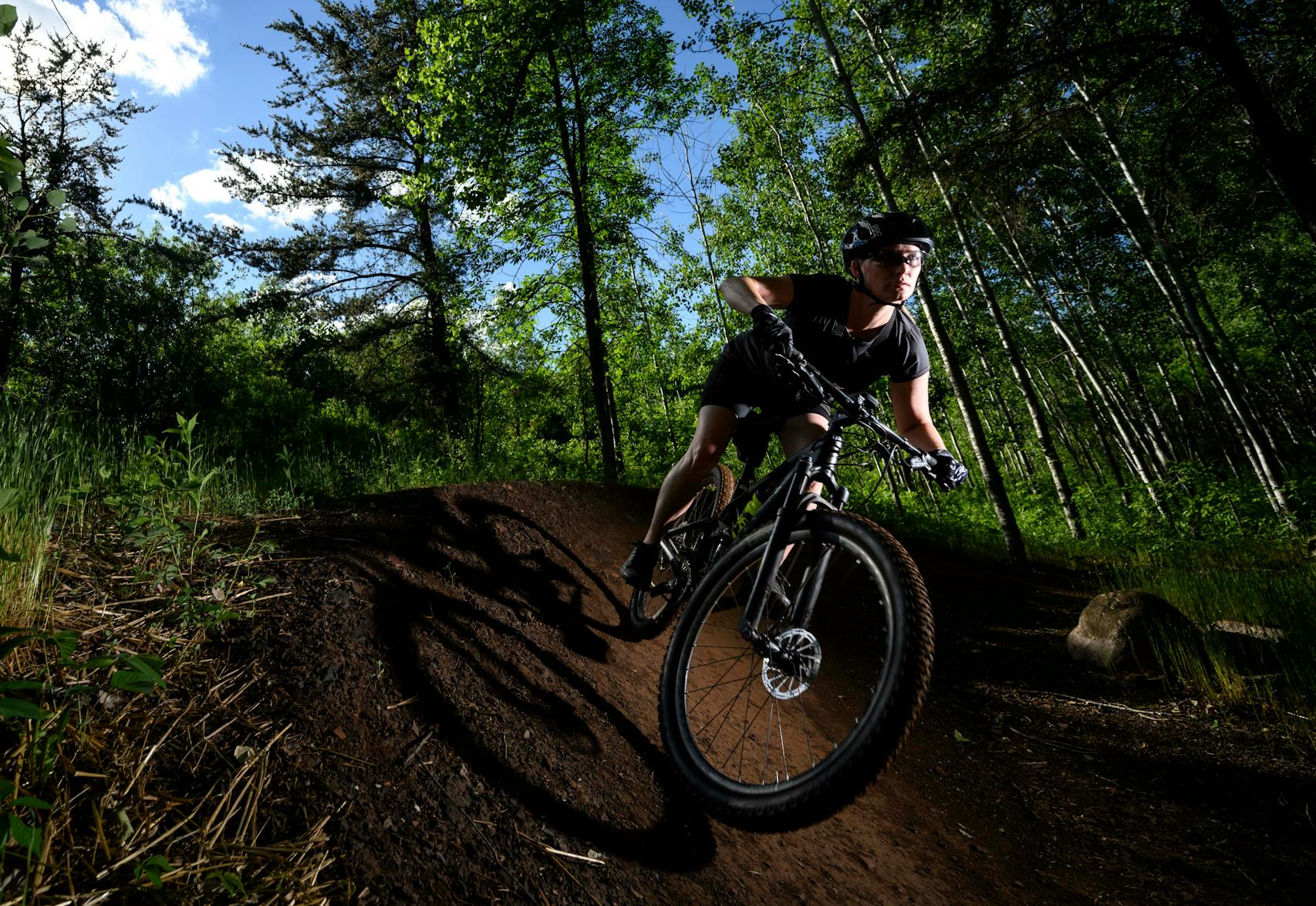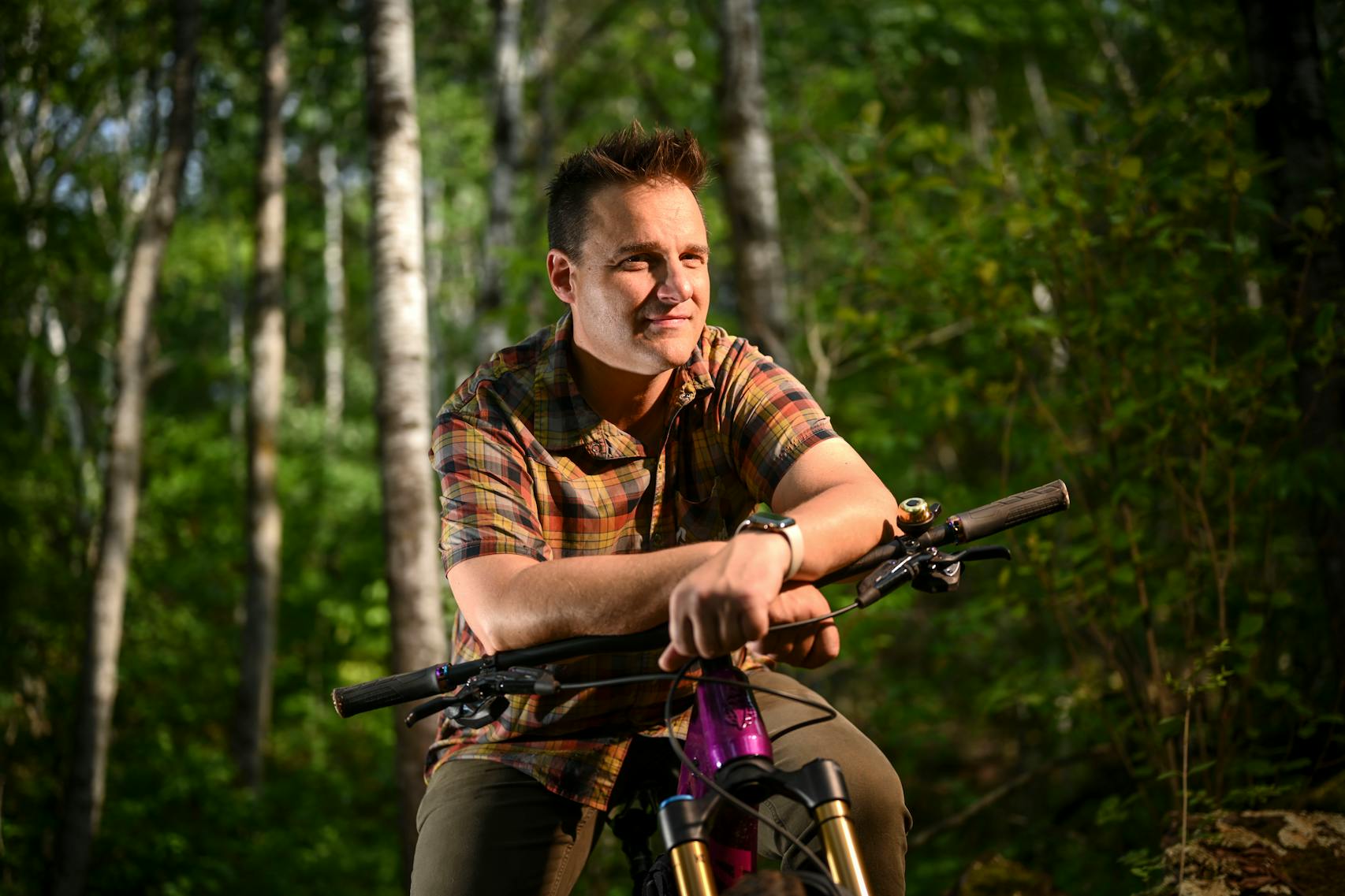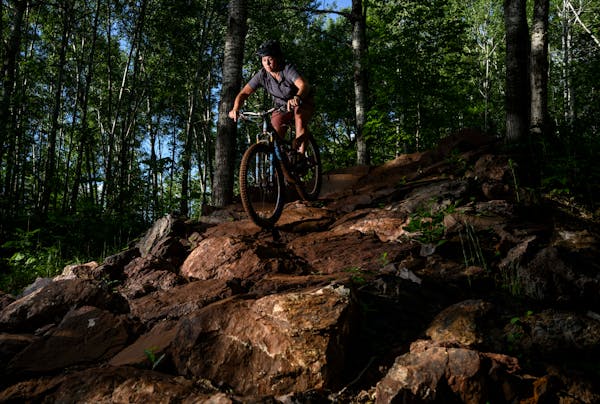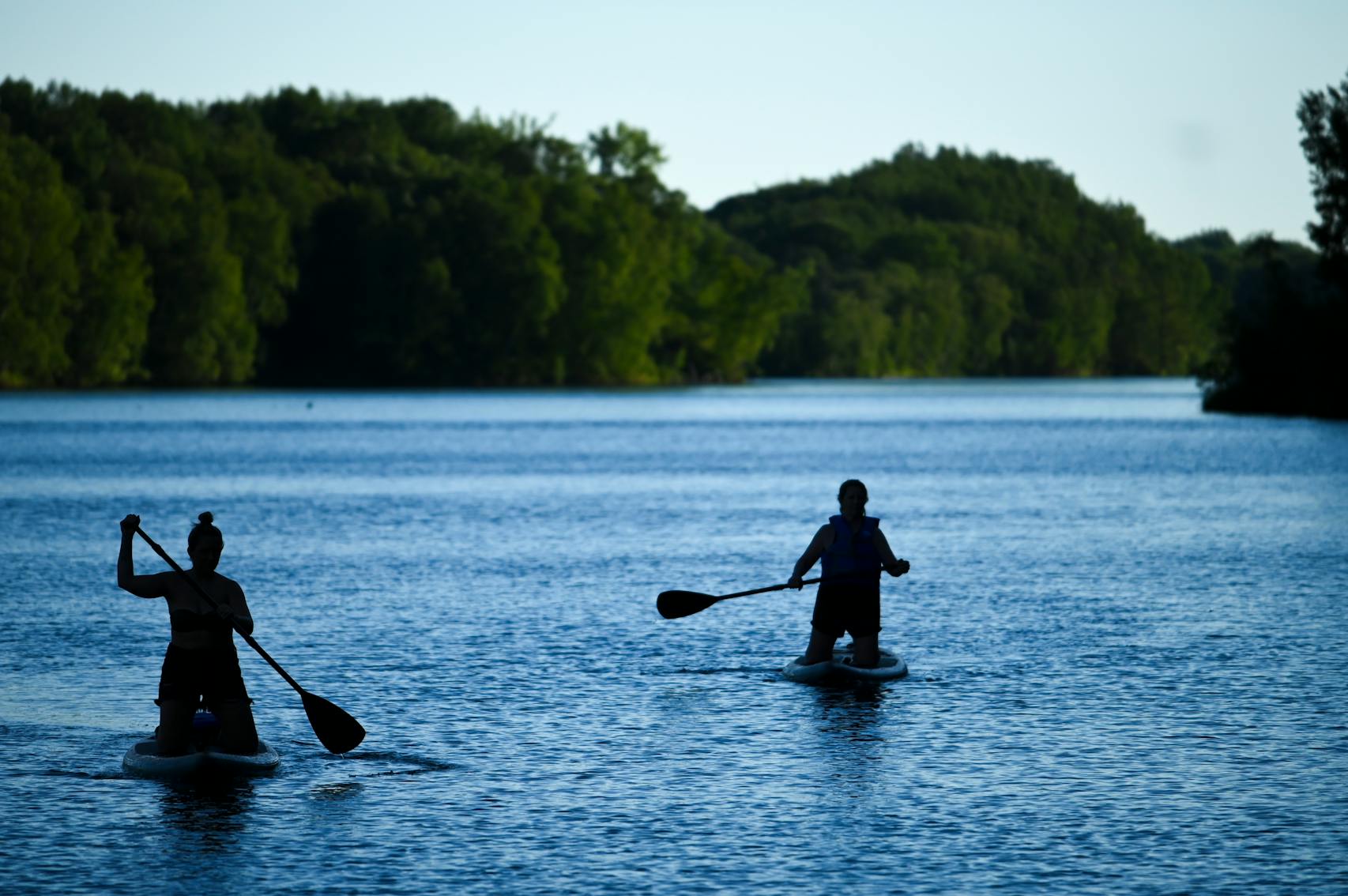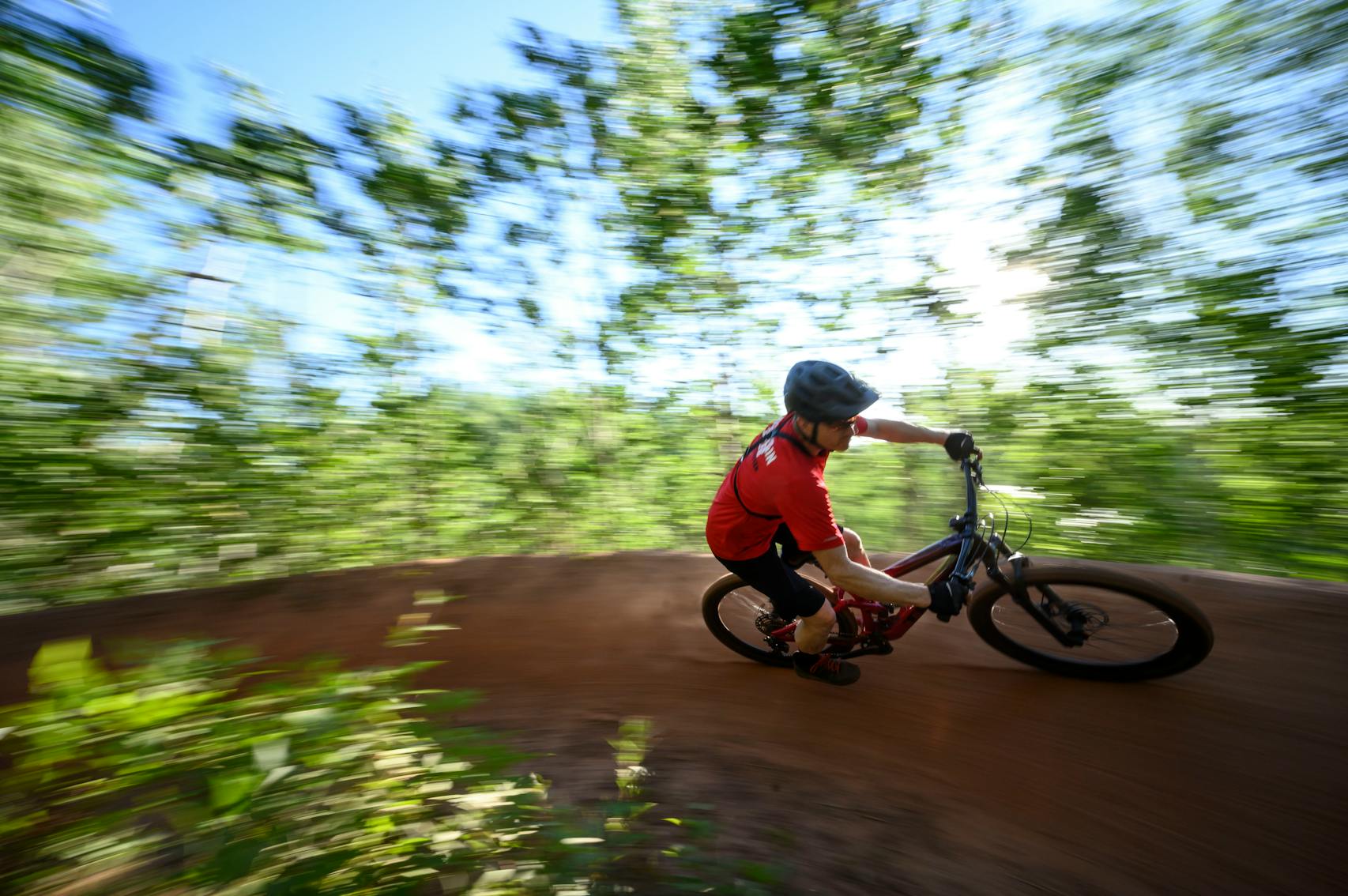IN THE CROSBY-IRONTON AREA – The helmets were a bit tippy for some, not entirely snug. The bike jerseys had some extra room, for now. And getting comfortable on their bikes? With practice, that would come, too, for the youngest of a local crop of "Little Bellas," mountain bikers in the making.
Under a still-hard sun on a weeknight in mid-June, riding mentors and their young charges, those Little Bellas ages 7 to 13, had their weekly meetup at Cuyuna Country State Recreation Area in north-central Minnesota. It was time to build more skills and confidence. And the scene had a sweet harmony: Here were people growing into their potential in state parkland seemingly with unlimited possibilities.
The Little Bellas were the future running through the past, on the area's trails. Once the land was a field of work for miners on this part of the Iron Range, whose pursuit of iron-ore reshaped and bulldozed the land into a rolling terrain of red earth tailings, ridges and mine pits. Now, the area is an increasingly popular field of play. And not only for wheeled adventure-seekers.
The first trails opened 10 years ago, and an area known as "Cuyuna Country" since has taken on a different resonance. Mountain biking is the star with megawatt cachet, but its supporting cast glows, too. The recreation area's water – it has six natural lakes and 15 crystalline mine lakes – is a paradise for scuba divers, paddlers and anglers. And within the recreation area's 5,000 acres, there is room to do more.
Like the network of trails, a labyrinth of storylines in communities nearby make up the Cuyuna Lakes region: The rec area is a blueprint for other Range towns like Cohasset and Chisholm regenerating old mine territories; it is a prideful bridge to the past; and, as with Little Bellas, it is attracting all comers and has energized a part of rural Minnesota through recreation tourism. The park had nearly 500,000 visits in 2020, and nearly 161,000 who rolled on trails. (The latter stat projects to nearly $16 million injected into the local economy based on cyclist-spending estimates.)
John Schaubach, who lives near Deerwood and moved to the area in 1978, said the vigor is authentic.
"It's real," said Schaubach, a retired hospital administrator who's seen the highly regarded Cuyuna Regional Medical Center use Cuyuna Country as one of its recruiting tools. "People are seeing how to have their dream exist here."
Laying foundations
As many as 30 mines, mostly underground, operated on the Cuyuna Range during the first world war. Open-pit mines followed, with production peaking in 1953. Mining declined rapidly by the early '60s, and by 1982 iron ore shipments from this part of the Range ground to a halt. Now, as some in the region like to say, the recreation area is extracting "smiles for miles."
There weren't so many smiles after the mines closed, though. The area was multi-use in a different way. People camped anywhere or motored through. Needed to get rid of an old fridge or old sofa? You had a spot. Even after it was designated a state recreation area by the state in 1993 through the work of such locals as Barb Grove, dubbed "Mama Cuyuna," who was the director of the Cuyuna Region Economic Development Inc. and had a seat on the state's Iron Range Resources and Rehabilitation Board (IRRRB).
In the following years, trail associations recognized the opportunities on the landscape. In 2005, U.S. Rep. Jim Oberstar, the late Iron Range Democrat, helped secure $750,000 in federal transportation funding to create the recreation area's mountain biking trail system. Private fund-raising, Legacy Amendment funds and, most recently, funds from a 2017 bonding bill and IRRRB grants have helped expand the trail system.
Meanwhile, during a bitter school strike in 2005 in the Crosby-Ironton District, community volunteers rallied around an idea to bridge bickering neighbors: build a new playground in Crosby's main public park. As many as 200 volunteers worked six consecutive days to complete it in 2007. The park was a vehicle for securing buy-in and sweat equity for ideas with potential. Like, say, biking trails that were on the horizon.
"In small towns, someone is always asking for help. We need to swing hammers ourselves," recalled Michelle LeMieur, one of the organizers.
More revitalization projects followed, from community gardens to strategically placed signage to greet visitors in Deerwood, Crosby, Ironton and Cuyuna.
"We were trying to align Cuyuna Lakes with the [Cuyuna Lakes State] bike trail. The bike trail was aligned with the mountain biking trails, and it all came at one pivotal moment," said Johnna Johnson, former director of the Cuyuna Lakes Chamber of Commerce.
A continuing project is public art: Eight building murals have been painted across communities since 2010, highlighting the recreation but, too, the history. "[History] has to be respected," LeMieur said. "And the people who built the area, their legacy has to be respected because there are so many of those generations still here."
Coming on board
In recent years, the region has attracted fresh faces ready to swing hammers – and given longtime residents a fresh perspective on the power of recreation to improve lives.
Chris Austin and Kelsey Braun bought 3 acres of woodland and water in 2018 just off Hwy. 6 on the edge of downtown Crosby. The story of the married couple's business — Cuyuna Cove and its five boutique cabins and glamping canvas tents — has attracted thousands of Instagram followers. From the days of decking out their 200-plus-square-foot dwellings of glass and oak to the finishing work. The hideaways opened in July 2020.
"Move your body; calm your life" is the message that they said they convey through social media and in person, Braun said. While both grew up in St. Cloud, their paths didn't cross until several years later. They were drawn to the Cuyuna Lakes area by friends, and then to the area's beauty and possibilities.
"Being up here allows us to move more, and that in turn helps our mental health. And we want to encourage that to our guests," Braun said.
Chuck Picard has built some foundations, too.
His introduction to the region came during a fat-tire bike ride in winter 2018. He was visiting from Bismarck, N.D. But he went from rider to resident in short order. Remote work, driven by the COVID-19 pandemic, gave Picard a new sense of mobility. Well, mountain biking, too. He said he also studied the master plan for the recreation area and its potential expansion.
Opportunity knocked – hard. Picard and a partner bought a five-bedroom investment property (called Camp Cuyuna) for $265,000 in Crosby and closed on it in June 2020. In January, he moved to Ironton, all the while keeping his IT manager job with the state of North Dakota.
Now, he's the vice president of the 300-member-strong Cuyuna Lakes Mountain Bike Crew and puts in more miles on two wheels than four.
"It was the perfect storm," said Picard of his life change.
Doug Houge, a longtime Crow Wing County commissioner, remembered when 40% of the storefronts in Crosby were closed and every block had a house for sale. The scene's flipped for everything from the signature antique dealers to bait shops, too. And a 38,000-square-foot Super One grocery store is going up off Hwy. 210 just east of downtown.
"And now we have a business, if you will, that isn't reliant on smokestacks," he said. "Tourism is something that is going to stick around. It is very exciting."
Forward together
Aaron Hautala, the former bike crew president who branded the region "Cuyuna Adventure Town USA," recalled hearing some residents complain about "all the cyclists" milling around as press and acclaim grew. "I just remember thinking, 'We don't have any other choices. We need to make it work.' "
For Hautala, dreams didn't have too high a price. He used his marketing savvy, keenly aware that the first biking trails in 2011 had to be the start line, not an endpoint. Cuyuna Country's continuing draw helped, for example, secure $3.6 million in a 2017 state bonding bill. That money helped build new "gravity flow" trails this summer for the advanced riders and a connector trail between the Yawkey Unit and city of Cuyuna. Now, there are more than 46 miles of singletrack (55, including Crusers Kettle trail built outside the rec area). The Sagamore Unit near Riverton alone will open 15 miles of new trail next year, including 5 miles for adapted riding, and it will include a much-needed 80-car parking lot.
The momentum is unmistakable.
"We painted a story, a very high-level story, an optimistic story, and it was like a magnet that brought in the right people who wanted to help tell it," Hautala said, sitting outside Red Raven, a bike and coffee hub that opened in 2015.
Barry Osborne has a high-level view, too. Long before becoming the park's manager, he got his start with the DNR and the recreation area 11 years ago. He recalled working on the very first mountain biking demo trail. And he sees a diversity of activity, from scuba to camping to paddling, that's getting attention, too. Yurts are packed, and park staff is focused on more water access points, for example, and developing routes for paddlers.
"There is something for everyone there. … There is room, and it's impressive," Osborne said.
Hautala equated the relationships built in the Cuyuna Lakes to the "purpose-built" trails. Nothing happens without the work, swinging hammers. "How can we ensure that this is sustainable, serves more than one purpose, and to ensure there is a bigger future? That is the hard part. That is the secret sauce," he said.
If people like Cuyuna, who knows what "Cuyuna 2.0" might attract, Hautala said.


